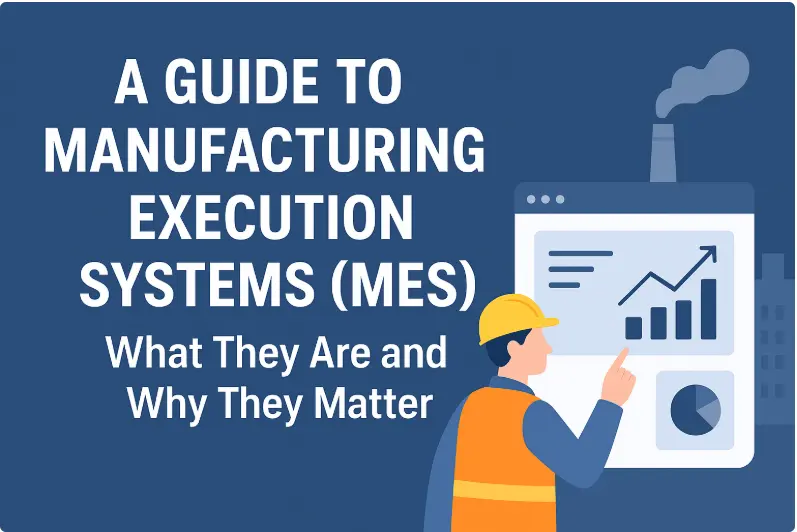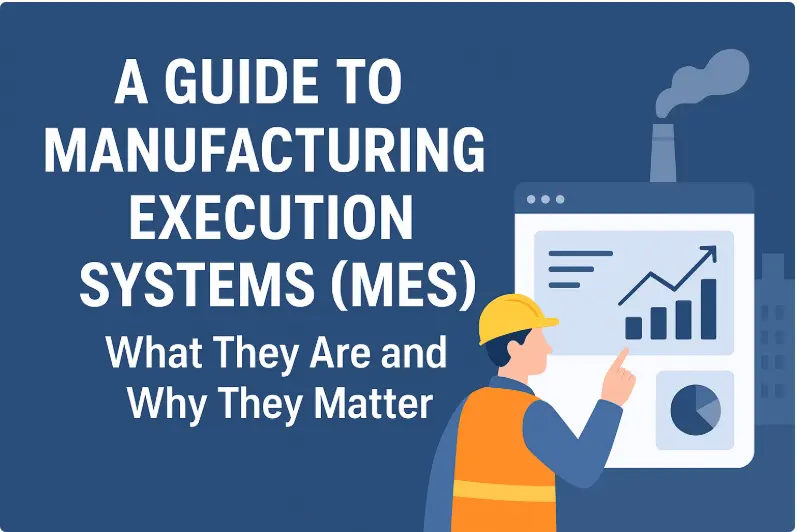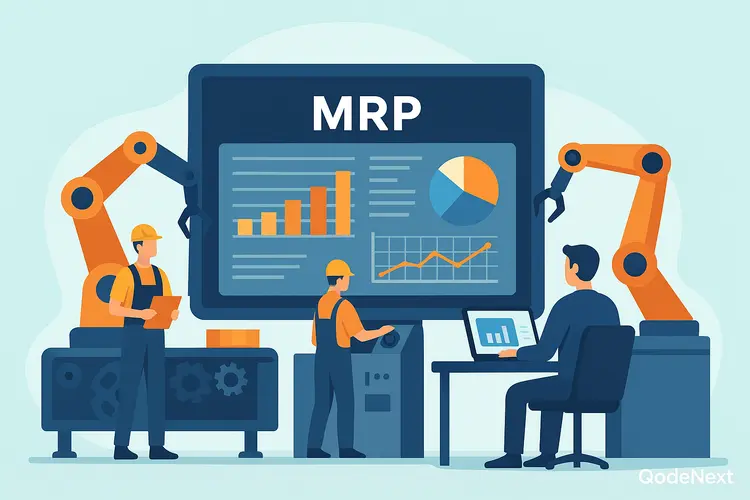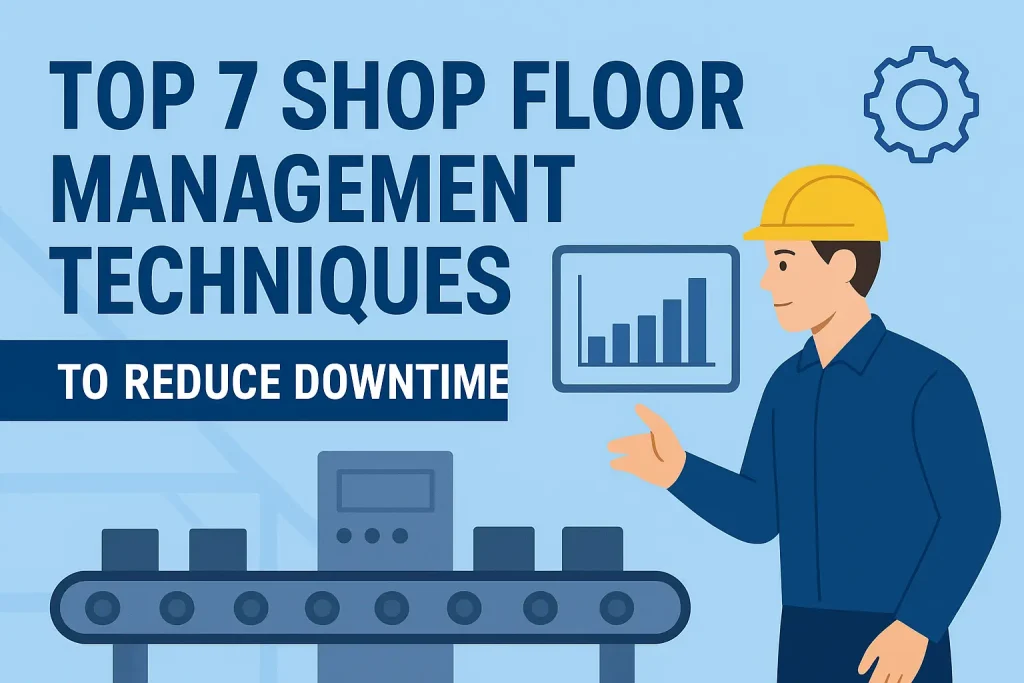If you’ve ever run a manufacturing business, you know how important it is to be precise, on time, and in control. A small delay, a lack of raw materials, or an incorrect report can all throw off your whole schedule.
That’s where a Manufacturing Execution System (MES) comes in. It’s a tool that links your planning layer to the work that happens on the shop floor. It makes sure that your plans come true and that you can see and control every step of the process in real time.
We’ll talk about what MES is, how it fits into operation management’s material requirement planning, and why it’s important for businesses that want to stay competitive and efficient.

What Exactly Is a Manufacturing Execution System (MES)?
A Manufacturing Execution System (MES) is a digital tool that monitors, tracks, and improves production processes.
It connects the machines, materials, and people on your factory floor to high-level planning systems like ERP and MRP.
MES gives you real-time information about how well your production is going, such as how much material is being used, how well machines are working, work orders, and product quality.
Manufacturers can use MES to answer important questions like:
- Are we reaching our production goals?
- Where are things taking longer than they should?
- How are materials being used in real time?
When used with material requirement planning in operations management, MES makes sure that production is not only planned but also carried out exactly as planned.
How MES Strengthens Material Requirement Planning
Material Requirement Planning (MRP) looks at what materials are needed, how many of them are needed, and when they are needed. It’s all about getting ready.
On the other hand, MES makes sure that planning leads to action.
This is how they work together:
- MRP makes sure that materials are available.
- MES makes sure that the materials are used well and that production stays on track with the plan.
They work together to make a connected ecosystem. In operation management, material requirement planning drives decisions, and MES makes sure those decisions happen smoothly on the floor.
MES in the Production Planning Process
The process of planning production decides how to use resources like people, machines, and materials. MES is very important here because it makes that static plan into a dynamic one.
What if one of your machines stops working? MES quickly records this and changes the production schedule, letting planners and supervisors know that they need to move resources around or change the timelines.
That means less disorder, fewer missed deadlines, and better management of production.
In short, MES changes planning from a set calendar to a flexible, data-driven system.
Inventory Control in Operations: How MES Adds Value
Finding the right amount of stock is key to good inventory management. Too much stock ties up money, and too little stops production.
- An MES helps maintain that balance by providing end-to-end inventory control in operations.
- By integrating MES with warehouse automation solutions, manufacturers can optimize material flow, reduce human error, and maintain real-time stock accuracy.
- It keeps track of how much raw material is used in each batch, how much is left, and when to order more.
- Your MRP or ERP systems will automatically update this information, which will stop you from running out of stock or buying too much.
Companies can see where materials are at every stage, from procurement to finished goods, in real time by syncing MES with material requirement planning in operation management.
MRP vs ERP Systems: Understanding Where MES Fits In
People often confuse MRP, ERP, and MES, but each one has a different job.
| System | Focus | Key Function |
| MRP (Material Requirement Planning) | Material availability | Calculates what’s needed and when |
| ERP (Enterprise Resource Planning) | Enterprise-wide coordination | Manages finance, HR, procurement, and reporting |
| MES (Manufacturing Execution System) | Real-time production execution | Tracks, monitors, and optimizes shop floor operations |
When we compare MRP vs ERP systems, MES acts as the operational backbone that ensures both of them stay accurate.
It takes plans from ERP or MRP and makes sure that every step of the production process is done on the ground, giving managers visibility and control at every step.
The Benefits of Material Requirement Planning and MES Integration
Manufacturers get a lot out of using both MRP and MES together. They work together to make operations more organised, visible, and flexible. Manufacturers can put lean manufacturing principles into action by using MES and MRP together. This cuts down on waste, speeds up workflows, and boosts productivity at every stage of the shop floor.
1. Full visibility of production
MES keeps track of everything, from raw materials to finished goods, so you can always know what’s going on in the production cycle.
2. Solving Problems in Real Time
MES lets you know right away about problems or delays instead of waiting for end-of-day reports.
3. More accurate predictions
MES improves demand forecasting and resource planning by sending real-time data back to the MRP system.
4. Quality and Compliance
By keeping track of performance and inspection data, MES makes sure that every product meets the quality standards set.
5. Saving money and being more efficient
Optimized production schedules, reduced downtime, and controlled material usage all translate into measurable cost savings.
These are the real benefits of material requirement planning when reinforced by MES — efficiency, accuracy, and control across every stage of manufacturing.
Why MES Matters More Than Ever
Today’s supply chains depend on speed, personalisation, and reliability. Even the best plans can fail if they aren’t carried out correctly or if the data is out of date.
MES makes sure that your planning, execution, and quality assurance all work together and not in separate areas.
It gives manufacturers the power to:
- Be quicker to respond to changes in demand
- Use automation to cut down on mistakes made by people.
- Connect production with systems at the enterprise level
- Keep all departments open and honest with each other.
By linking MES with material requirement planning in operation management, manufacturers can confidently scale up while staying efficient and competitive.
A Quick Reality Check: What Happens Without MES
Most factories use spreadsheets, manual updates, or separate software systems instead of MES. This often results in:
- Not being able to see things in real time
- Departments don’t work well together.
- Late answers to problems
- Incorrect information about production
An MES doesn’t just fix these problems; it stops them from happening in the first place. It lets manufacturers plan ahead instead of just reacting.
Real-World Example: MES in Practice
Consider a medium-sized electronics company that had been manually tracking its products for years.
They had trouble with inventory reports that didn’t match, missed deadlines, and having to redo work all the time because of miscommunication.
After they implemented MES and connected it to their existing material requirement planning in operation management system, everything changed:
- Live updates were made to production data.
- Tracking of material use was done automatically.
- Quality problems were reported right away
In six months, production delays went down by 30%, and they got much better at delivering on time.
Not only did MES make their process better, it completely changed how they did business.
Conclusion
A Manufacturing Execution System (MES) does more than just keep an eye on production; it helps manufacturers make better, faster, and more confident choices.
When MES becomes part of your wider logistics digitalisation strategy, production data supports supply chain decisions, resulting in faster, smarter operations.”
When you connect MES with material requirement planning in operation management, you close the gap between what is planned and what is done.
The result?
A factory that can change quickly, works well, and is ready for the future.
If you want to really improve your production planning process, better control inventory control in operations, and put insights into action, MES is the tool that will help you do it.
FAQs: A Guide to Manufacturing Execution Systems (MES)
Can MES work without ERP or MRP integration?
Yes, but only to a point. For basic tracking and monitoring, MES can work on its own. But connecting it to ERP or MRP makes sure that data flows smoothly and production is better coordinated.
How long does it take to implement an MES in a mid-sized manufacturing unit?
The time it takes to implement can be anywhere from three to nine months, depending on how complicated the system is, how many processes there are, and how well it needs to work with other systems.
Is MES only for large enterprises?
Not at all. Many modern MES solutions are modular and scalable, so they can be used by small and medium-sized manufacturers who want to go digital.
What data does MES collect during production?
MES records information about things like how well machines work, how efficiently operators work, how much material is used, why machines go down, production rates, and quality standards.
How does MES contribute to sustainability in manufacturing?
MES helps manufacturers reach their long-term production goals without hurting their bottom line by cutting down on waste, making the best use of energy, and making processes run more smoothly.






